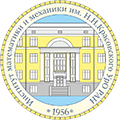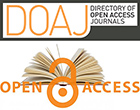SOME TRIGONOMETRIC SIMILARITY MEASURES OF COMPLEX FUZZY SETS WITH APPLICATION
Abstract
Similarity measures of fuzzy sets are applied to compare the closeness among fuzzy sets. These measures have numerous applications in pattern recognition, image processing, texture synthesis, medical diagnosis, etc. However, in many cases of pattern recognition, digital image processing, signal processing, and so forth, the similarity measures of the fuzzy sets are not appropriate due to the presence of dual information of an object, such as amplitude term and phase term. In these cases, similarity measures of complex fuzzy sets are the most suitable for measuring proximity between objects with two-dimensional information. In the present paper, we propose some trigonometric similarity measures of the complex fuzzy sets involving similarity measures based on the sine, tangent, cosine, and cotangent functions. Furthermore, in many situations in real life, the weight of an attribute plays an important role in making the right decisions using similarity measures. So in this paper, we also consider the weighted trigonometric similarity measures of the complex fuzzy sets, namely, the weighted similarity measures based on the sine, tangent, cosine, and cotangent functions. Some properties of the similarity measures and the weighted similarity measures are discussed. We also apply our proposed methods to the pattern recognition problem and compare them with existing methods to show the validity and effectiveness of our proposed methods.
Keywords
Full Text:
PDFReferences
- Alkouri A.U.M., Salleh A.R. Linguistic variables, hedges and several distances on complex fuzzy sets. J. Intell. Fuzzy Syst., 2014. Vol. 26, No. 5. P. 2527–2535. DOI: 10.3233/IFS-130923
- Balopoulos V., Hatzimichailidis A.G., Papadopoulos B.K. Distance and similarity measures for fuzzy operators. Inform. Sci., 2007. Vol. 177, No. 11. P. 2336–2348. DOI: 10.1016/j.ins.2007.01.005
- Bi L., Dai S., Hu B. Complex fuzzy geometric aggregation operators. Symmetry, 2018. Vol. 10, No. 7. Art. no. 251. DOI: 10.3390/sym10070251
- Bi L. et al. Complex fuzzy arithmetic aggregation operators. J. Intell. Fuzzy Syst., 2019. Vol. 36, No. 3. P. 2765–2771. DOI: 10.3233/JIFS-18568
- Bosteels K., Kerre E.E. A triparametric family of cardinality-based fuzzy similarity measures. Fuzzy Sets and Systems, 2007. Vol. 158, No. 22. P. 2466–2479. DOI: 10.1016/j.fss.2007.05.006
- Bouchon-Meunier B., Coletti G., Lesot M.-J., Rifqi M. Towards a conscious choice of a fuzzy similarity measure: a qualitative point of view. In: Lecture Notes in Computer Sci., vol. 6178: Computational Intelligence for Knowledge-Based Systems Design. IPMU 2010. E. Hüllermeier, R. Kruse, F. Hoffmann (eds.). Berlin, Heidelberg: Springer, 2010. P. 1–10. DOI: 10.1007/978-3-642-14049-5_1
- Camastra F. et al., Fuzzy similarity-based hierarchical clustering for atmospheric pollutants prediction. In: Lecture Notes in Computer Sci., vol. 11291: Fuzzy Logic and Applications. WILF 2018. Fullér R., Giove S., Masulli F. (eds.). Cham: Springer, 2019. P. 123–133. DOI: 10.1007/978-3-030-12544-8_10
- Cheng S.-H., Chen S.-M., Jian W.-S. Fuzzy time series forecasting based on fuzzy logical relationships and similarity measures. Inform. Sci., 2016. Vol. 327. P. 272–287. DOI: 10.1016/j.ins.2015.08.024
- Chen S.-M., Yeh M.-S., Hsiao P.-Y. A comparison of similarity measures of fuzzy values. Fuzzy Sets and Systems, 1995. Vol. 72, No. 1. P. 79–89. DOI: 10.1016/0165-0114(94)00284-E
- Ciaramella A., Nardone D., Staiano A. Data integration by fuzzy similarity-based hierarchical clustering. BMC Bioinformatics, 2020. Vol. 21, No. Suppl. 10. Art. no. 350. DOI: 10.1186/s12859-020-03567-6
- Couso I., Garrido L., Sánchez L. Similarity and dissimilarity measures between fuzzy sets: a formal relational study. Inform. Sci., 2013. Vol. 229. P. 122–141. DOI: 10.1016/j.ins.2012.11.012
- De Baets B., De Meyer H. Transitivity-preserving fuzzification schemes for cardinality-based similarity measures. European J. Oper. Res., 2005. Vol. 160, No. 3. P. 726–740. DOI: 10.1016/j.ejor.2003.06.036
- Goyal S., Kumar S., Shukla A.K. Fuzzy similarity measure based spectral clustering framework for noisy image segmentation. Internat. J. Uncertain. Fuzziness Knowledge-Based Systems, 2017. Vol. 25, No. 4. P. 649–673. DOI: 10.1142/S0218488517500283
- Guo W., Bi L., Hu B., Dai S. Cosine similarity measure of complex fuzzy sets and robustness of complex fuzzy connectives. Math. Probl. Eng., 2020. Vol. 2020. Art. no. 6716819. DOI: 10.1155/2020/6716819
- Hesamian G., Chachi J. On similarity measures for fuzzy sets with applications to pattern recognition, decision making, clustering, and approximate reasoning. J. Uncertain Systems, 2017. Vol. 11, No. 1. P. 35–48.
- Hu B., Bi L., Dai S. The orthogonality between complex fuzzy sets and its application to signal detection. Symmetry, 2017. Vol. 9, No. 9. Art. no. 175. DOI: 10.3390/sym9090175
- Hyung L.-K., Song Y.-S., Lee K.-M. Similarity measures between fuzzy sets and between elements. Fuzzy Sets and Systems, 1994. Vol. 62, No. 3. P. 291–293. DOI: 10.1016/0165-0114(94)90113-9
- Lee S.-H., Pedrycz W., Sohn G. Design of similarity and dissimilarity measures for fuzzy sets on the basis of distance measure. Int. J. Fuzzy Syst., 2009. Vol. 11, No. 2. P. 67–72.
- Li C., Wu T., Chan F.-T. Self-learning complex neuro-fuzzy system with complex fuzzy sets and its application to adaptive image noise canceling. Neurocomputing, 2012. Vol. 94. P. 121–139. DOI: 10.1016/j.neucom.2012.04.011
- Liu P., Ali Z., Mahmood T. The distance measures and cross-entropy based on complex fuzzy sets and their application in decision making. J. Intell. Fuzzy Syst., 2020. Vol. 39, No. 3. P. 3351–3374. DOI: 10.3233/JIFS-191718
- Ma J., Zhang G., Lu J. A method for multiple periodic factor prediction problems using complex fuzzy sets. IEEE Trans. Fuzzy Syst., 2011. Vol. 20, No. 1. P. 32–45. DOI: 10.1109/TFUZZ.2011.2164084
- Ma J., Feng L., Yang J. Using complex fuzzy sets for strategic cost evaluation in supply chain downstream. In: 2017 IEEE Int. Conf. on Fuzzy Systems (FUZZ-IEEE), 2017. P. 1–6. DOI: 10.1109/FUZZ-IEEE.2017.8015452
- Pal A. et al. Similarity in fuzzy systems. J. Uncertain. Anal. Appl., 2014. Vol. 2, No. 18. DOI: 10.1186/s40467-014-0018-0
- Pappis C.P., Karacapilidis N.I. A comparative assessment of measures of similarity of fuzzy values. Fuzzy Sets and Systems, 1993. Vol. 56. P. 171–174. DOI: 10.1016/0165-0114(93)90141-4
- Ramot D. et al., Complex fuzzy sets. IEEE Trans. Fuzzy Syst., 2002. Vol. 10, No. 9. P. 171–186. DOI: 10.1109/91.995119
- Raha S., Hossain A., Ghosh S. Similarity based approximate reasoning: fuzzy control. J. Appl. Log., 2008. Vol. 6. P. 47–71. DOI: 10.1016/j.jal.2007.01.001
- Ren S., Ye J. Multicriteria decision-making method using cosine similarity measures for reduct fuzzy sets of interval-valued fuzzy sets. J. Comput., 2014. Vol. 9, no. 1. P. 107–111. DOI: 10.4304/jcp.9.1.107-111
- Sahoo L. Similarity measures for Fermatean fuzzy sets and its applications in group decision-making. Decis. Sci. Letters, 2022. Vol. 11. P. 167–180. DOI: 10.5267/j.dsl.2021.11.003
- Van der Weken D. at al. A survey on the use and the construction of fuzzy similarity measures in image processing. In: CIMSA. 2005 IEEE International Conference on Computational Intelligence for Measurement Systems and Applications, Giardini Naxos (ed), Italy, 20-22 July 2005, 2005. P. 187–192. DOI: 10.1109/CIMSA.2005.1522858
- Wang W.J. New similarity measures on fuzzy sets and on elements. Fuzzy Sets and Systems, 1997. Vol. 85, No. 3. P. 305–309. DOI: 10.1016/0165-0114(95)00365-7
- Xuecheng L. Entropy, distance measure and similarity measure of fuzzy sets and their relations. Fuzzy Sets and Systems, 1992. Vol. 52. P. 305–318. DOI: 10.1016/0165-0114(92)90239-Z
- Yang M.-S., Hung W.-L., Chang-Chien S.-J. On a similarity measure between LR-type fuzzy numbers and its application to database acquisition. Int. J. Intell. Syst., 2005. Vol. 20. P. 1001–1016. DOI: 10.1002/int.20102
- Yeung D.S., Tsang E.C.C. A comparative study on similarity based fuzzy reasoning methods. IEEE Trans. SMC Part B: Cyber., 1997. Vol. 27, No. 2. P. 216–227. DOI: 10.1109/3477.558802
- Zadeh L.A. Fuzzy sets. Inform. Control, 1965. Vol. 8, No. 3. P. 338–353. DOI: 10.1016/S0019-9958(65)90241-X
- Zhang G. et al. Operation properties and δ-equalities of complex fuzzy sets. Int. J. Approx. Reason., 2009. Vol. 50, No. 8. P. 1227–1249. DOI: 10.1016/j.ijar.2009.05.010
- Zwick R., Carlstein E., Budescu D. Measures of similarity among fuzzy sets: A comparative analysis. Int. J. Approximate Reasoning, 1987. Vol. 1. P. 221–242. DOI: 10.1016/0888-613X(87)90015-6
Article Metrics
Refbacks
- There are currently no refbacks.













